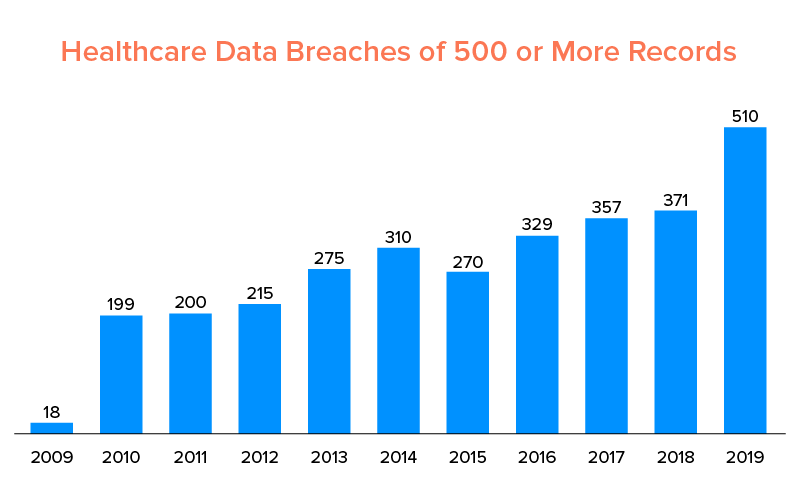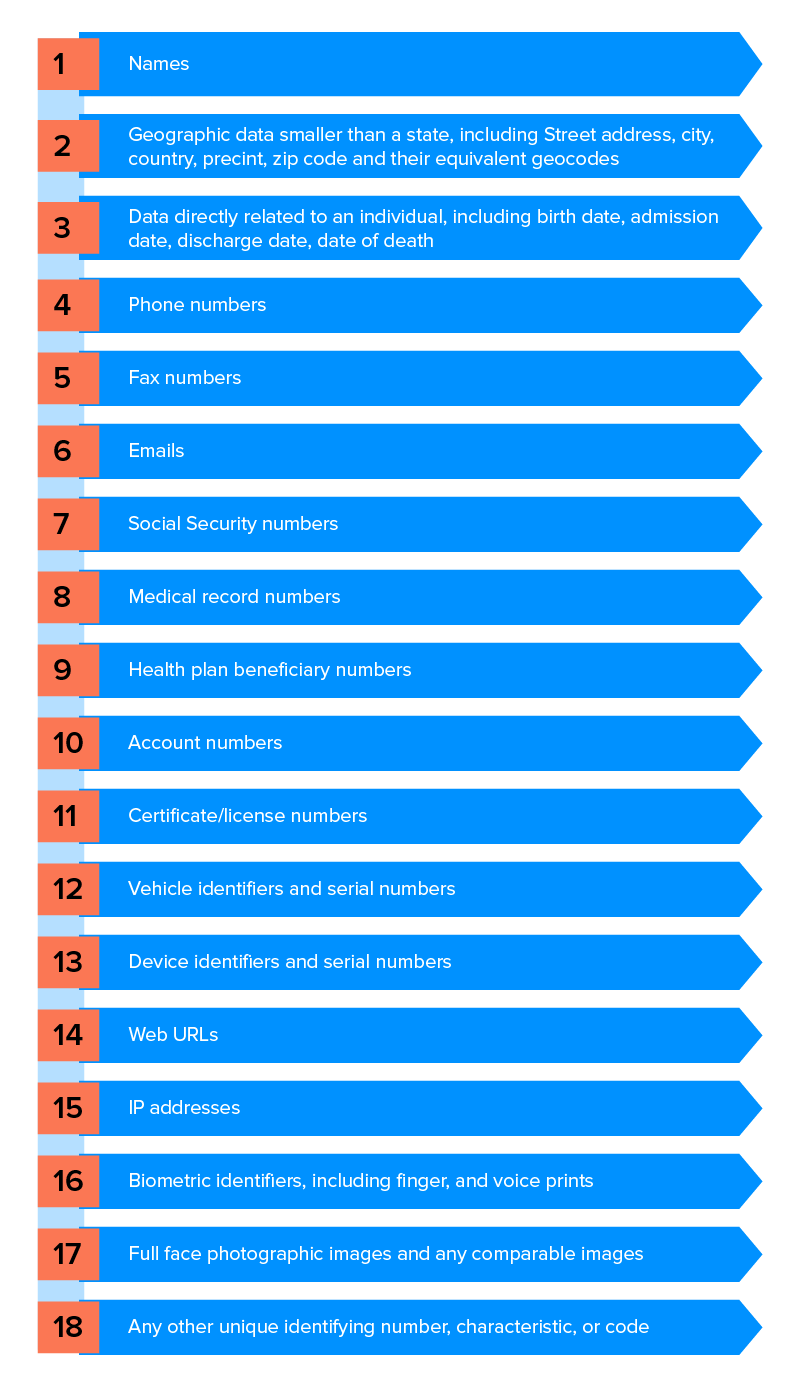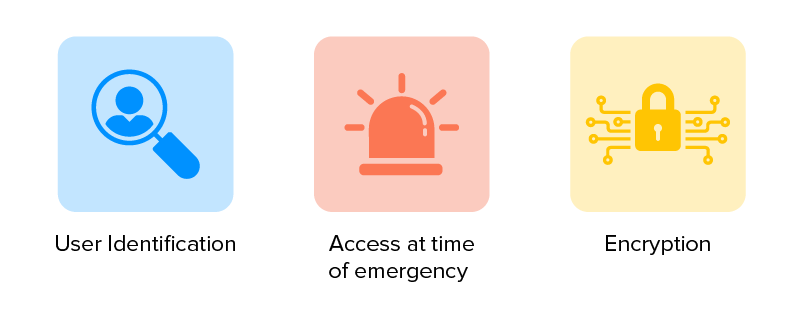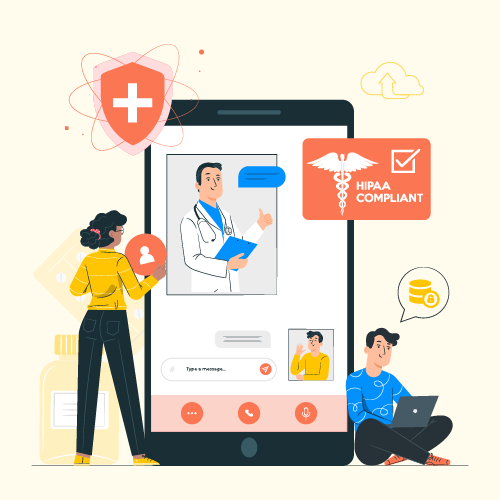An Entrepreneur’s Guide on How to Develop a HIPAA Compliant Mobile Application
If you have ever interacted with the healthcare industry, there are high chances that you must have heard of HIPAA compliant apps. You must have also heard how it is a prerequisite for the development of healthcare applications. In this article, we will give you a basic insight in the developmental process of HIPAA app creation with the intent to help kickstart your healthcare digital transformation journey.
The era that we are presently living in operates under one simple formula – data is gold. When we look into any industry that deals with users’ data (sensitive or not) we are also bound to see some compliances in place aiming to make the industry more safeguarded.
Healthcare sector too, is not untouched by the need for strict compliances to save users’ data from getting misused in this mobile-first era.

Although the compliances vary from nation to nation, the one that has become universal on many grounds is the HIPAA – Health Insurance Portability and Accountability Act.
Let us look into the process of HIPAA compliant app development that ensures your application is developed to pass the requirements of the compliance.
What is the HIPAA act?
The HIPAA Act ensures there are zero anomalies when handling and storing patient data, especially on a software platform. It also includes sharing of information related to billing and healthcare insurance coverage for the medical patients.
The idea of developing mobile app HIPAA compliance was launched in 1996 for regulating protection of the patients’ data, lowering the healthcare cost, and providing health insurance coverage for people who lost or changed their jobs. However, the portion of the act that we are interested in as developers and you would be as app entrepreneurs is the requirement for ensuring that the app protects users against data fraud.
The first part of HIPAA regulation compliance understanding and implementation is to know the kind of data the healthcare software domain interacts with.
- PHI (Protected Health Information) — This set of information consists of doctor bills, MRI scans, emails, test results, and other medical information. Also, the geolocation details of someone within a territory is also counted as PHI.

- CHI (consumer health information) — These information consist of data which you can gather from a fitness tracker, example: number of calories burnt, heart rate readings, and number of steps.
When on the path of understanding mobile app HIPAA compliance, there is still a lot of confusion around why HIPAA rules are important. Let us answer the following.
What Makes HIPAA Compliance Important?
HIPAA regulation is a comprehensive act that has been enacted for helping both healthcare institutions and patients. Thus, understanding why it is important is necessary for both the stakeholders when building HIPAA compliant software.
For the Patients:
- No entity can forward any patient information without their consent – Under the HIPAA compliances, only the healthcare professionals can share the patients’ information with stakeholders. Also, only those stakeholders who attend the healthcare operations are to be covered under the PHI, this in turn, ensures high confidentiality and privacy levels.
- Billing professionals and prescription vendors cannot send patients’ information forward – Other stakeholders, as mentioned in the above point, are not allowed to send patients’ information forward.
- Entities should notify patients of a breach – The patients have complete right on their medical details. This allows smooth flow of data sharing among multiple healthcare institutions.
For Hospitals:
The importance of following mobile app HIPAA compliance for hospitals lies in the understanding of what would happen if they are not followed. In case of non-following compliances, hospitals are held liable to pay massive fines. An individual data breach case can amount to $100 to $50,000 in fine.
There are many live examples of how costly it can get for hospitals when they breach the HIPAA compliance – on both financial and image grounds. Example, in 2015, a Massachusetts hospital had to pay a $218,000 fine for putting the data of more than 500 patients at risk simply because their file sharing application didn’t meet the HIPAA security requirements.
How to Make HIPAA Compliant Mobile Apps?
Developing HIPAA compliant healthcare apps can at times pose a challenge for the healthcare app developers especially because it asks for a number of modifications on both features and design front.
Our experience of having developed more than 70+ mHealth solutions, have aided us with the creation of a HIPAA compliance checklist for software development. Here’s a peek into it –
Making of a HIPAA compliant phone app calls for following four primary rules:
- Privacy
- Security
- Enforcement
- Breach
While as an app entrepreneur, you would have to look into all the four rules, the one that healthcare app development company like us primarily work around when answering how to make software HIPAA compliant are the HIPAA privacy and security rules. They majorly consist of physical and technical safeguards.
Physical safeguards
It includes protection of the backend, network for data transfer, and devices that are on Android or iOS – ensuring that they cannot be compromised, lost, or stolen. To ensure applications’ security, you must enforce authentication while making it impossible to access apps without authentication – something that can be achieved through a multi-factor authentication system.
Technical safeguards
They focus on completely encrypting the data which can be transferred or stored on servers and devices. Some of the technical safeguard practices include:
- Emergency access process
- Unique user identification
- Automatic logoff
Another best practice in this regard can be following the minimum necessity requirements: Do not collect more data than you would need nor store data for longer than actually needed for work. Additionally, avoid transmission of PHI data in push notifications or leak the information in logs and backups.
Steps to Create HIPAA Compliant Apps
Here are the main steps to create HIPAA Compliant apps for mobile:
- Get help from experts: The whole process of HIPAA compliant app development is complex. So, don’t try to meet all HIPAA requirements without guidance if you don’t have enough experience. It’s better to contact a reputed HIPAA compliant software development company. Taking help from experienced healthcare app developers for Compliant Application Development will make the task easy for you and help you prepare better. Hiring an expert is beneficial for both startups and big healthcare companies.
- Evaluate patient data: Any healthcare institution will have access to confidential patient data. This data can be stored, shared and maintained via a mobile app. You need to analyze and identify what comes under the purview of PHI. Once you do that, see what PHI data you can avoid storing or transferring through your mobile app.
- Find HIPAA compliant third-party solutions: Providing HIPAA compliant for an app is very expensive. In such situations, it’s advisable to use infrastructure and solutions that are already HIPAA compliant instead of developing HIPAA compliant mobile apps from scratch. This is called IaaS — Infrastructure as a service. For example, Amazon Web Services and TrueVault are compliant with HIPAA and are responsible for data security.
If you are using a third-party solution provider for storing and managing PHI data, you’ll need to sign a business associate agreement with third-party companies and make sure they’re reliable.
- Protect sensitive data: Use best security measures to protect sensitive data of your patients. Use several levels of encryption and make sure there are no security breaches.
- Maintain and test your app for security: Testing your app is really important. Do it after every update. If there is any issue with your app, it can be fixed immediately.
Maintenance is a constant process that you need to follow in order to keep your app safe and secure. After you build a HIPAA-compliant app, you’ll need to make sure you update it regularly; otherwise, a security breach can occur.
Generic Features of a HIPAA Compliant Applications

While like other mobile app sectors, no two healthcare applications are also the same. There are, however, some features that are common in all the HIPAA compliant healthcare application development processes, as we have also covered in our mHealth application development guide.
User Identification: For the authentication of users, the best thing can be to ask them for a PIN or password. You can also take the feature up a notch by implementing biometric identification and smart cards.
Access at time of emergency: In case of natural emergencies, the network conditions and essential services might face a disruption. While it is not a direct requirement to arrange for these instances, it would be a good decision, consciously to have a provision that addresses these issues.
Encryption: The data which is stored or being transmitted has to be encrypted. When you use services like Google Cloud or AWS which runs Transport Layer Security 1.2, you automatically get end to end encryption in place. Although TLS can be enough, it can be a good move to fortify it further with AES encryption.
Which Healthcare Apps Should Comply With HIPAA rules?
When we gauge an application against the need to comply with the HIPAA privacy rule, we majorly consider three criterias to define which of them are HIPAA compliant applications:
Entity
When an application is used by some covered entity like a hospital, physician, or a healthcare insurance provider, they will most likely comply with the HIPAA compliant software development requirements.
Example, in case you plan to design an application which facilitates patient-doctor interaction, it would have to comply with the HIPAA rules because both hospitals and doctors are covered entities. On the other hand, an application which solely helps a person in following a medication schedule, it won’t necessarily have to follow the HIPAA privacy rules since there are no covered entities involved.
When we talk about entities, it is important to look into the Privacy Rule. The rule addresses what is Protected Health Data while defining who is responsible for ensuring that the PI detail is not disclosed.
According to Privacy Rule, there are two types of organizations which are subjected to the HIPAA law compliance:
- Business associate: They are the entities which collect, store, process, and then transmit PHI on the behalf of the covered entities.
- Covered entities: They are the healthcare organizations, providers, clearinghouses, etc who perform some administrative and financial transactions electronically. Some of those transactions include fund transfer, electronic billing, etc.
Data
Mobile app HIPAA compliance is mainly concentrated on protected health information – any medical information which can be used to identify an individual along with the data that has been created, utilized, or disclosed in the time when healthcare organizations managed services like diagnosis or treatment was offered.
PHI consists of two sections: personally identifiable information and medical data. An important thing to note here is that only when a personally identifiable information is linked with the medical data, the information becomes PHI.
For example, an application that helps physicians in diagnosing skin diseases by studying the anonymous photos does not interact with any PHI. However, when you mention the patients’ name or address, it would become a PHI.
To summarise: When the information shared or stored in an application can be identifiable individually, it must comply with the HIPAA law compliances. The same rule applies when the sensitive data is stored on some third-party server.
Software security
The last factor which helps identify whether or not healthcare app development falls in the HIPAA rules is related to the employed technology and consists of multiple standards applied for protection and control access of the electronic protected health information (ePHI).
These standards mainly consist of integrity, audit, and access controls.
The Steps That Appinventiv Follows For Making HIPAA Compliant Application
At Appinventiv, our focus is always on a safety-first mobile app development approach. Whether we are developing a Fintech application or On-demand software, the priority always lies on ensuring that under every condition, the users’ data are safeguarded.
When we make HIPAA compliant mobile apps, there are several requirements that we abide by in our role as a custom healthcare software development company. Let’s take a look at them.
1. Transport Encryption
When building HIPAA compliant software, it is mandatory to keep the health data encrypted in transmissions. The first step that we follow to achieve that is using HTTP protocols and SSL. In the case of client-server data transfer, when the data has to be transmitted in the body of the POST requests, we first encrypt them on the sender’s front and then decrypt them on the receiver’s side. This helps with the prevention of man-in-the-middle attacks. Additionally, we transmit and store passwords in hash values to safeguard compromising of data.
2. Backup
The hosting providers that we partner with offer recovery and backup services, this ensures that the data is not lost in case of emergency or accident. Example, if the web software sends the data elsewhere, the messages get backed up, securely stored, and made accessible to the authorized staff.
3. Authorization
Our team of mHealth app experts build and upgrade your medical app in a way that the authorization is well protected. Some of the ways we do that are: audit the access control, secure the logins which ensure that the data can only be accessed by the authorized personnel.
4. Integrity
When developing HIPAA compliant mobile apps, it is important that an infrastructure is set up that would ensure that the collection, storage, and transfer of information is safe and cannot be altered in any way, whether intentionally or by mistake.
The first step in this regard, is to make sure the system can detect and report unauthorized data tampering, even when the tiniest bit of information is changed. Measures like encryption, regular backup, access authorization along with properly defined users role and privilege in addition to the restriction of physical access to infrastructure become must-have elements when making HIPAA compliant applications.
5. Storage Encryption
The rule of dealing with PHI is that it should only be available to authorized personnel. We cover all the data which are stored in the software system – backups, databases, and logs – in this rule. Our experts apply industry backed encryption with the help of RSA and AES algorithms with strong keys. We even make use of encrypted databases like SQLCipher for storing the data on the backend safely.
6. Disposal
It is of prime importance that the archived and backup data which have expired would be disposed off permanently. We take measures to dispose of all the unused data in a safe, non-retrievable manner.
How we manage PHI collection, transmission, and storage
When planning our PHI management process, we look into three situations:
- When the information is in transit – between device and server – We make use of modern cipher suites and TLS to manage data on the move. In cases where the devices operate in untrusted networks such as public wi-fi, we make use of the certificate pinning process
- When the information is on the server-side – once the data has entered the server storage, we make provisions around key rotation, key management, encrypted backup, audit logging etc.
- When the information is at rest on device – iOS and Android generally tend to store that data on disks when the network is offline. This in turn, can attract heavy penalties and fines. Thus, it is important that the data is well encrypted.
Conclusion
Driven by the impact of coronavirus pandemic on the healthcare sector, we are soon entering the phase where digital healthcare transformation will be the new norm. It means, in the time to come, there would be a sharp shift to a focus on compliance adherence. The healthcare digital transformists who end up understanding the nuances of the compliances and implementing them in their medical software today will see the most success.
[Also Read: A Pocket Guide to Healthcare Compliances]

strategies your digital product..





